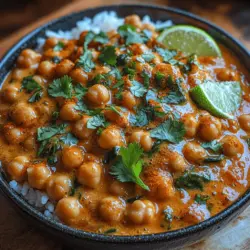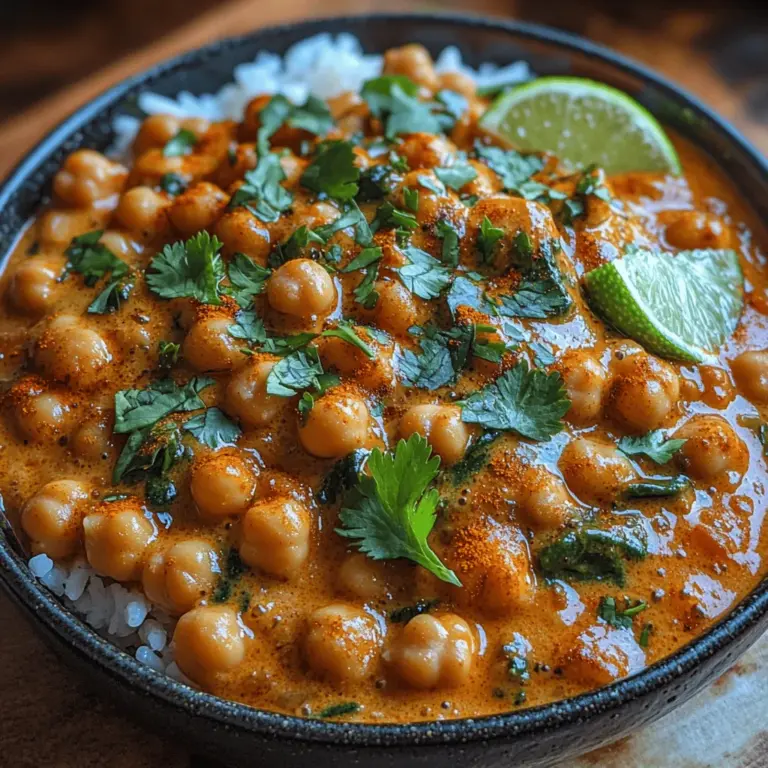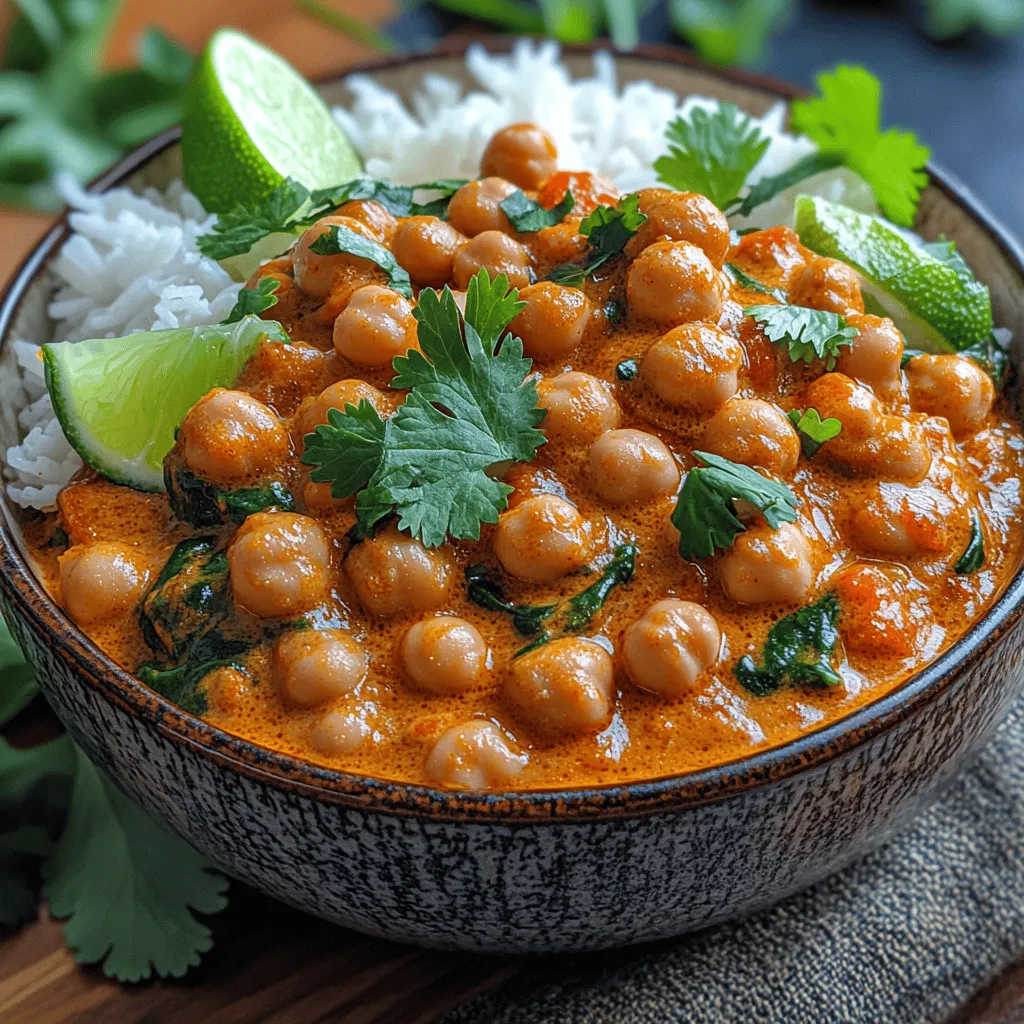Introduction
Welcome to a culinary journey that will take your taste buds to tropical paradise with a delightful and nourishing dish: Creamy Coconut Chickpea Curry. This vibrant and hearty curry offers a perfect balance of flavor and nutrition, making it a staple in plant-based diets. As more people seek to incorporate plant-based meals into their daily lives, recipes like this one provide an enticing alternative that is not only satisfying but also beneficial for overall health.
In today’s fast-paced world, convenience in meal preparation is essential. This creamy coconut chickpea curry is not only simple to prepare but also ideal for weeknight dinners or meal prepping for the week ahead. With minimal fuss and a short cooking time, you can whip up a dish that pleases the palate and nourishes the body. Whether you’re a seasoned cook or new to the kitchen, this recipe is designed to be accessible while delivering maximum flavor and comfort.
Understanding the Ingredients
Chickpeas: A Nutritional Powerhouse
At the heart of this curry lies chickpeas, also known as garbanzo beans. These legumes are a fantastic source of plant-based protein, making them an excellent choice for vegetarians and vegans alike. Just one cup of cooked chickpeas provides approximately 15 grams of protein and about 12 grams of dietary fiber, contributing to better digestion and a feeling of fullness. Their versatility in cooking is unparalleled; chickpeas can be roasted for a crunchy snack, blended into hummus, or, as in this recipe, simmered into a delightful curry.
In addition to their protein content, chickpeas are rich in essential nutrients such as iron, magnesium, and B vitamins. Incorporating chickpeas into your diet can help support muscle growth, bone health, and energy metabolism, making them a smart choice for a balanced diet.
The Creamy Goodness of Coconut Milk
Coconut milk is the secret ingredient that gives this curry its rich and creamy texture. Derived from the flesh of mature coconuts, this dairy-free alternative is not only delicious but also packed with health benefits. It contains medium-chain triglycerides (MCTs), which may support weight management and provide a quick source of energy.
Moreover, coconut milk is a source of healthy fats that can enhance the absorption of fat-soluble vitamins such as A, D, E, and K. Its creamy consistency adds depth to the curry, creating a luscious sauce that perfectly complements the chickpeas and vegetables. When selecting coconut milk, opt for full-fat varieties for the best flavor and creaminess, or you can use light coconut milk for a lower-calorie option without sacrificing too much on taste.
Aromatics: Building Flavor Foundations
No curry is complete without the aromatic trio of onion, garlic, and ginger. These ingredients are fundamental in creating a flavor base that elevates the dish to new heights. Onions provide sweetness and depth, while garlic and ginger contribute pungency and warmth. Together, they create a balanced and aromatic foundation that enhances every bite of the curry.
When preparing your curry, take the time to sauté these aromatics properly. Cooking them until soft and translucent will unlock their natural sugars and develop their flavors, setting the stage for a deliciously layered dish.
The Spice Symphony: A Blend of Health and Flavor
The spices used in this creamy coconut chickpea curry are what truly bring the dish to life. A blend of curry powder, cumin, turmeric, and garam masala not only adds vibrant color but also infuses the curry with a complex flavor profile.
– Curry Powder: A staple in many Indian dishes, curry powder typically contains a mix of spices such as coriander, cumin, and turmeric. It offers a warm, earthy flavor and is known for its anti-inflammatory properties.
– Cumin: This spice adds a nutty and peppery flavor to the dish. Cumin is rich in antioxidants and has been studied for its potential benefits in digestion and metabolism.
– Turmeric: Known for its bright yellow color, turmeric contains curcumin, a compound celebrated for its anti-inflammatory and antioxidant effects. It’s also what gives the curry its beautiful golden hue.
– Garam Masala: A blend of spices that varies by region, garam masala typically includes cinnamon, cardamom, and cloves. It adds warmth and sweetness to the curry, making it a complex and inviting dish.
Fresh Produce: Nutrient Boosters
To round out this dish, vibrant fresh produce such as bell peppers, tomatoes, and spinach play a crucial role. These vegetables not only enhance the visual appeal but also contribute essential vitamins and minerals.
– Bell Peppers: Available in various colors, bell peppers are high in vitamins A and C, as well as antioxidants. They add a sweet crunch to the curry, balancing the creaminess of the coconut milk.
– Tomatoes: Fresh tomatoes bring acidity and brightness to the dish, cutting through the richness of the coconut milk. They are also a great source of vitamins C and K, as well as potassium.
– Spinach: This leafy green is a nutritional powerhouse, loaded with iron, calcium, and vitamins A and C. Adding spinach at the end not only boosts the nutrition of the curry but also adds a lovely pop of green.
Step-by-Step Guide to Making Creamy Coconut Chickpea Curry
Preparation Tips
Before diving into the cooking process, it’s essential to prepare your ingredients properly. Start by draining and rinsing your chickpeas if you’re using canned ones, as this helps remove excess sodium and improves their flavor. If you prefer using dried chickpeas, soak them overnight and cook them until tender before adding them to the curry. This ensures the best texture and flavor in your dish.
Sautéing the Aromatics
To kick off the cooking process, heat a tablespoon of oil in a large skillet or pot over medium heat. Once the oil is shimmering, add finely chopped onions and sauté for about 5-7 minutes, or until they become translucent and golden. The key here is to stir occasionally to prevent burning. Once the onions are ready, add minced garlic and grated ginger, cooking for another 2-3 minutes. This will infuse the oil with their aromatic flavors, creating a fragrant base for your curry.
Cooking the Vegetables
Next, it’s time to add your bell peppers and diced tomatoes to the pan. Cook them for about 5-7 minutes until they soften and the tomatoes begin to break down. This step is crucial as it develops the sauce’s flavor and adds a natural sweetness to the curry. Stir occasionally to ensure even cooking and prevent sticking.
Incorporating the Spices
Once your vegetables are cooked, it’s time to add the spices. Sprinkle in the curry powder, cumin, turmeric, and a pinch of salt. Toasting the spices in the hot oil for about 1-2 minutes will awaken their essential oils and deepen the flavor of the curry. Be sure to stir continuously to prevent burning and create a fragrant aroma that will fill your kitchen.
Adding Chickpeas and Coconut Milk
Now, it’s time to introduce the star ingredients: the chickpeas and coconut milk. Add the rinsed chickpeas to the pan, stirring to combine them with the aromatic mixture. Pour in the coconut milk and give everything a good stir. Bring the mixture to a gentle simmer, allowing it to cook uncovered for about 10-15 minutes. This simmering process is vital, as it allows the flavors to meld together beautifully while thickening the sauce.
Final Touches
As your curry simmers, keep an eye on the consistency. If you prefer a thicker curry, let it cook a bit longer, stirring occasionally. Just before serving, fold in a handful of fresh spinach and a squeeze of lime juice to brighten the flavors. The heat from the curry will wilt the spinach, adding a fresh element to the dish. Finally, finish with a sprinkle of garam masala for an extra layer of warmth and complexity.
This curry is not only a feast for the senses but also a nourishing meal that celebrates the vibrancy of plant-based cooking. In the next part of this article, we will dive deeper into serving suggestions, storage tips, and variations to customize this dish according to your taste preferences.
Nutritional Information
Creamy Coconut Chickpea Curry is not only a delicious dish but also packed with beneficial nutrients. Let’s delve into the health benefits of its key ingredients:
– Chickpeas: Rich in protein and fiber, chickpeas support digestive health and keep you feeling full longer. They are an excellent source of vitamins and minerals, including iron, magnesium, and folate.
– Coconut Milk: Although higher in fat, coconut milk contains medium-chain triglycerides (MCTs), which are known for their health benefits, including improved metabolism and energy levels. It also offers a dose of healthy fats essential for nutrient absorption.
– Tomatoes: Loaded with antioxidants, particularly lycopene, tomatoes contribute to heart health and may protect against certain cancers. They also provide hydration due to their high water content.
– Spices: Ingredients like turmeric and ginger not only elevate the flavor but also boast anti-inflammatory properties, which can enhance overall wellness.
Nutritional Breakdown (per serving):
– Calories: Approximately 350
– Protein: 12 grams
– Fat: 20 grams
– Carbohydrates: 35 grams
– Fiber: 10 grams
– Vitamins: Rich in vitamins A, C, and B6.
This dish is versatile and suitable for various dietary preferences, including vegan and gluten-free diets. It is also high in protein due to the chickpeas, making it a satisfying meal option for those looking to maintain a balanced diet without sacrificing flavor.
Serving Suggestions
The beauty of Creamy Coconut Chickpea Curry lies not just in its flavor but also in how it can be enjoyed. Here are some ideal serving suggestions:
– Accompaniments: This curry is best served with cooked rice or naan. The rice absorbs the luscious curry sauce, creating a delightful balance of textures and flavors. Naan, on the other hand, provides a soft, chewy counterpart that can be used to scoop up the curry, enhancing the overall dining experience.
– Garnishing: Fresh cilantro and a squeeze of lime juice can elevate your dish dramatically. The cilantro adds a burst of freshness and a hint of earthiness, while the lime juice helps to cut through the richness of the coconut milk, brightening the overall flavor profile of the curry.
– Side Dishes: To round out your meal, consider serving a simple cucumber salad or roasted vegetables on the side. These options will add crunch and freshness, complementing the creamy texture of the curry.
Variations and Customizations
One of the great aspects of this Creamy Coconut Chickpea Curry is its adaptability. Here are some variations and customizations you can make to suit your taste:
– Ingredient Substitutions: If you find yourself missing certain ingredients, don’t worry! For instance, you can replace chickpeas with lentils or beans based on preference. If coconut milk is unavailable, almond or cashew milk can work, though they will yield a different flavor profile.
– Extra Protein or Vegetables: To amp up the protein content, consider adding tofu or tempeh. For a veggie boost, incorporate spinach, kale, or bell peppers. These additions not only enhance nutritional value but also add color and texture to your dish.
– Adjusting Spiciness: If you like your curry with a kick, feel free to add more chili powder or fresh chili peppers. Conversely, if you prefer a milder flavor, reduce the amount of spice or omit it altogether.
Storage and Reheating Instructions
For those who might have leftovers (or want to meal prep), here are the best practices for storing and reheating:
– Storing Leftovers: Allow the curry to cool to room temperature before transferring it to an airtight container. This will help retain its freshness and flavor. The curry can be refrigerated for up to 4-5 days or frozen for up to three months. If freezing, consider portioning it out for easy reheating later.
– Reheating Methods: To reheat, you can use either the stovetop or microwave. For stovetop reheating, place the curry in a saucepan over medium heat, stirring occasionally to ensure even heating. If using a microwave, heat in short intervals (1-2 minutes), stirring in between to prevent hot spots. Regardless of the method, add a splash of water or coconut milk if the curry thickens too much during storage.
Conclusion
In summary, Creamy Coconut Chickpea Curry is an outstanding dish that combines quick preparation with nutritious ingredients, making it a comforting meal for busy weeknights or leisurely weekends. Its versatility allows for numerous adaptations, encouraging you to experiment with flavors and ingredients that suit your personal palate.
Cooking with whole, plant-based ingredients not only nourishes the body but also brings a sense of joy and togetherness when shared with others. Whether you enjoy it with friends or family, this curry is sure to become a favorite in your household. Embrace the warmth and richness of this dish, and let it inspire your culinary creativity!



